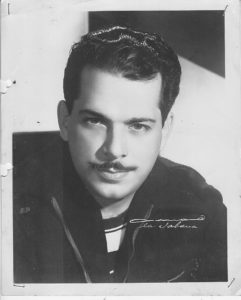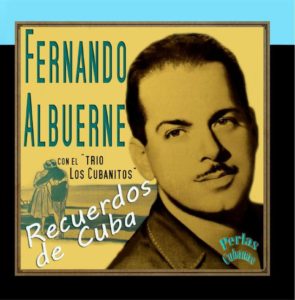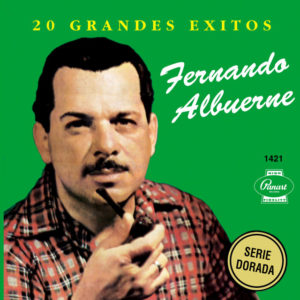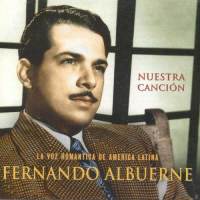 FERNANDO ALBUERNE, DESTACADO CANTANTE CUBANO, CONOCIDO COMO “LA VOZ DE TERCIOPELO”
FERNANDO ALBUERNE, DESTACADO CANTANTE CUBANO, CONOCIDO COMO “LA VOZ DE TERCIOPELO”
Luis Fernando Albuerne Garcell, con nombre artístico Fernando Albuerne, nació el 28 de octubre de 1920 en Sagua de Tánamo, provincia de Oriente, a 50 km al norte de Guantánamo, Cuba, su voz llegó a ser considerada “La Voz de Terciopelo” por quienes lo escucharon.
Se graduó en Ingeniería Agrícola en la Universidad de La Habana y comenzó a trabajar en la empresa Albuerne Soap, propiedad de su padre.
Aunque carecía de conocimiento musical, estaba totalmente entusiasmado con el canto, y estaba consolidando su voz y estilo en la familia y entre sus compañeros, convirtiéndose de un intérprete de canciones cubanas en uno de los grandes intérpretes vocales del material español en general.
Su primera presentación se realizó el 17 de noviembre de 1941, en “Radio Cadena Suaritos” con el tema “Come to Love”, donde trabajó durante más de 12 años.
Sin embargo, a principios de sus veinte años, Albuerne cambió el curso del mundo de los negocios a un contrato exclusivo con Radio Cadena.
https://youtu.be/YgTtBkM2du4
A finales de los años 40, tenía demanda de actuaciones en teatros y cabarets, así como en la televisión. Comenzó a recorrer América Latina; en 1953, Albuerne triunfó en escenarios de capitales europeas como Madrid, Lisboa y París. Albuerne está cerca de la parte superior de cualquier lista alfabética de artistas cubanos que huyeron del régimen de Fidel Castro cuando la tinta todavía se estaba secando en los calendarios de 1960.
Hizo presentaciones en Puerto Rico, Venezuela, Brasil, Chile, Uruguay y Argentina. Estando en Buenos Aires, hizo presentaciones de radio y grabó para el sello Odeon el vals “Dices que tengo celos”. Este álbum lo convirtió en el ganador de su primer disco de oro, superando el millón de copias vendidas.
Además, a principios de la década de 1950 actuó en ciudades de Europa como Lisboa, Madrid y en la televisión francesa.
Salió de Cuba en 1960 y se fue a Venezuela, estableciéndose en Caracas durante muchos años. Grabó su primer álbum en Venezuela y esto incluye su famoso tema “El hijo se fue de Cuba”. Albuerne se mudó a Miami en la década de 1970.
En 1979 participó en esta ciudad en “The Show of the Greats”. Durante estos años grabó sus grandes recopilaciones y discos que hoy en día se venden.
https://youtu.be/TjphlCgx9mY
Actuó y grabó en todo el mundo de habla hispana y, a veces, vivió en Caracas, Venezuela, así como en Cuba y, finalmente, en Tampa, FL.
Su posterior residencia en Caracas agudizó aún más su imagen como intérprete latino con una perspectiva global.
El sello Rodven ha lanzado una serie de álbumes bajo el nombre de Albuerne, incluida la romántica e informativa Historia de Amor. En conjunto, la discografía de Albuerne representa una excelente colección de canciones cubanas y mexicanas.
Murió en Miami el 8 de julio de 2000.
 FERNANDO ALBUERNE, PROMINENT CUBAN SINGER, ALSO KNOWN AS “THE VELVET VOICE”.
FERNANDO ALBUERNE, PROMINENT CUBAN SINGER, ALSO KNOWN AS “THE VELVET VOICE”.
Luis Fernando Albuerne Garcell, with Artistic name Fernando Albuerne, was born on October 28, 1920, in Sagua de Tánamo, Oriente Province, 50 km north of Guantanamo, Cuba.
He was graduated in Agricultural Engineering at the University of Havana and began working in the company Albuerne Soap owned by his father.
Even though it lacked musical knowledge was totally enthusiastic about singing, and was consolidating its voice and style at family and among his fellow students developing from a performer of Cuban songs into one of the great vocal interpreters of Spanish material in general.
His first presentation was made on November 17, 1941, in “Radio Cadena Suaritos” with the theme “Come to Love,” where he worked for more than 12 years.
Early in his twenties, however, Albuerne switched course from the business world to an exclusive contract with Radio Cadena.
By the late ’40s, he was in demand for performances in theaters and cabarets as well as on television. He began touring Latin America; in 1953, Albuerne triumphed on stages in European capitals such as Madrid, Lisbon, and Paris. Albuerne is near the top of any alphabetical list of Cuban performers who fled the regime of Fidel Castro when the ink was still drying on 1960 calendars.
He made presentations in Puerto Rico, Venezuela, Brazil, Chile Uruguay, and Argentina. Being in Buenos Aires, he made radio presentations and recorded for the Odeon label the Waltz “Dices que tengo celos.” This album made him the winner of his first gold record, surpassing a million copies sold.
Also, at the beginning of the 1950’s he performed in cities of Europe like Lisbon, Madrid and on French television.
He left Cuba in 1960 and went to Venezuela, settling in Caracas for many years. He recorded his first album in Venezuela and this includes his famous theme “El Son se fue de Cuba”. Albuerne moved to Miami in the 1970s.
In 1979 he participated in this city in “The Show of the Greats.” During these years he recorded his great compilations and records that nowadays are sold.
He performed and recorded throughout the Spanish-speaking world and at times lived in Caracas, Venezuela, as well as Cuba and eventually Tampa, FL.
His subsequent residency in Caracas further sharpened his image as a Latin performer with a global outlook.
The Rodven label has released a series of albums under Albuerne’s name, including the both romantic and informative Historia de Amor. Taken as a whole, the Albuerne discography represents a superb collection of Cuban and Mexican songs.
He died in Miami July 8, 2000.
Agencies/ Music Guide/ Chadbourne/ Internet Photos/ YouTube/ Arnoldo Varona/ www.thecubanhistory.com
THE CUBAN HISTORY, HOLLYWOOD.



 < FERNANDO ALBUERNE, Prominent Cuban Singer, Also Known as "The Velvet Voice".
< FERNANDO ALBUERNE, Prominent Cuban Singer, Also Known as "The Velvet Voice".





